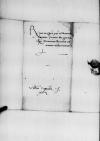Quod petit Reverendissima Dominatio Vestra, ut per sacram ⌊maiestatem regiam⌋ libera esse possit a futuris ⌊comitiis⌋, id perinde esse videtur ac si quis a peccato, quod committere decrevit, absolutionem petat. Prius committi peccatum, deinde absolutio peti consuevit. Quod vero postulat, ut ne ad nuptias[1] proficisci necesse habeat, quas id ob causas impetrare conetur, ex iis, quae Reverendissima Dominatio Vestra ad dominum ⌊Hosium⌋ ⌊⌋, cognovi. Et nos, qui versamur in aula sacrae ⌊maiestatis regiae⌋, eadem causa a perpetuis nuptiis, hoc est a perpetuo sumptu et apparatu, qui certe census nostros superat, deterrere posset. Nihilominus non solum cf. Vulg. Mt 20:12 qui portavimus pondus diei et aestus ⌊pondus diei et aestum ferimuscf. Vulg. Mt 20:12 qui portavimus pondus diei et aestus ⌋, verum etiam impensas facimus maiores, quam pro facultatibus nostris et novum indies aes alienum conflamus, dum voluntati serenissimorum ⌊principum⌋ pro eorum et nostra dignitate servire studemus. Ego vero vereor, ne duplex iter duplices sumptus facere Reverendissima Dominatio Vestra cogatur. Ad nuptias quando proficiscendum illi sit, quandoquidem dies illarum incertus est, certum non habemus, sed in causa illustris domini ⌊ducis Prussiae⌋ iam est Reverendissima Dominatio Vestra inter commissarios nominata, ad quam rem prius illi fortasse proficiscendum erit. Mihi tamen curae futurum, si qua ratione ab alterutro itinere ineundo libera esse possit Reverendissima Dominatio Vestra, modo cognoscere ex ea possim ad nuptiasne, an ad negotium domini ⌊ducis⌋ constituendum proficisci malit.
De rebus Danicis quae scribit Reverendissima Dominatio Vestra, communicavi cum sacra ⌊maiestate regia⌋. Displicet ⌊illi⌋, sed quid agat, non videt. Dominus ⌊dux⌋ omnem operam suam defert ad reducendos in concordiam ⌊principes⌋. Quod dat, accipimus.
De ⌊citatis⌋ habita hic est diligens consultatio. Quod petit Reverenda Dominatio Vestra, ut remittantur ad ⌊comitia terrarum Prussiae⌋, id non est visum esse ex dignitate sacrae ⌊maiestatis regiae⌋. Quod si nullius sibi rei conscii sunt, nihil est, quod metuant. Vult ⌊maiestas regia⌋ experiri, quam sibi eos habeat dicto audientes, si venerint ad diem sibi dictum, etiamsi fortasse non se usquequaque purgare possent. Ego tamen in gratiam Reverendissimae Dominationis Vestrae libenter omnem operam interponam, ut ne quid in eos durius consulatur. Sin autem contumaces esse voluerint, daturos eos suae contumaciae poenas dubium non est.
Commendo officiosam voluntatem meam Reverendissimae Dominationi Vestrae.
Reverendissima Dominatio Vestra ⌊⌋ quidem, quae obicienda putaret ⌊citatis⌋, sed quemadmodum ea essent probanda, non scripsit. Proinde et hoc mihi significare ne gravetur, unde sint probationes earum rerum petendae, quae obici ⌊citatis⌋ debent, et curet, si fieri potest, citationis exemplum ad me perferendum, neque enim id apud me habeo.



